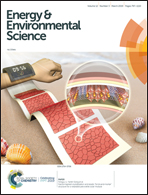Transient, in situ synthesis of ultrafine ruthenium nanoparticles for a high-rate Li–CO2 battery†
Abstract
Li–CO2 batteries are considered promising approaches for reducing the “greenhouse effect” and taking advantage of the abundant CO2 in the atmosphere for use in energy storage devices, due to the molecule's reversible reaction with Li. However, Li–CO2 batteries suffer from several setbacks, such as poor rechargeability and low Coulombic efficiency. Designing and fabricating a highly efficient cathode is one of the key components to improving the electrochemical performance. For the first time, we demonstrate a transient, in situ thermal shock method combined with a three-dimensional cross-linked structure derived from CO2 gasification to produce a high dispersion of ultrafine Ru nanoparticles on activated carbon nanofibers to serve as an efficient cathode in Li–CO2 batteries. The interconnected channels, numerous pores, ultrafine nanoparticles, and highly crystalline structure promote the diffusion of CO2 and the permeation of electrolyte, enhancing the catalytic decomposition of discharge products in Li–CO2 batteries. These devices exhibit not only impressive cycling performance with a limited capacity of 1000 mA h g−1, but also a low overpotential due to the sufficient number of active sites on the cathode. The electrode displays a low overpotential of 1.43 V after 50 cycles at 0.1 A g−1. Furthermore, low overpotentials of 1.79 and 1.81 V can be achieved even at elevated current densities of 0.8 and 1.0 A g−1, respectively. In comparison, the previously reported overpotentials were up to 1.95 and 1.90 V at low current densities of 0.1 and 0.2 A g−1, respectively, indicating the Ru nanoparticles on the carbon nanofibers display excellent catalytic performance towards the reaction of Li and CO2. Therefore, this approach offers a new pathway to high performance Li–CO2 batteries and may spur further applications in catalysis and other renewable energy storage technologies.



 Please wait while we load your content...
Please wait while we load your content...